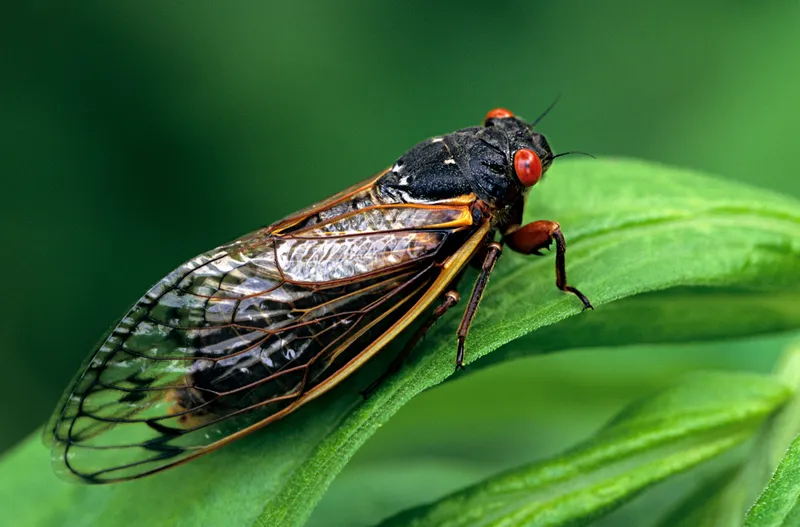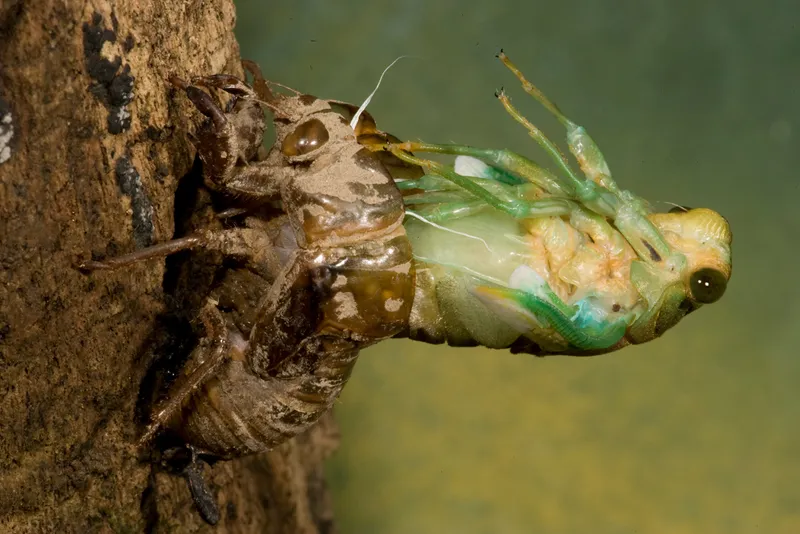Remember back in 2021 when Brood X emerged after spending 17 years underground, sending everyone into a frenzy? Well, prepare yourself, because a cicada explosion is coming to the US. And it’s coming soon.
What is a cicada?
Cicadas are large, robust insects, with transparent wings and large compound eyes. They have a distinctive corrugated exoskeletal structure on the sides of their abdomen called a ‘tymbal’, and it’s this organ that produces the loud buzzing sound.
By rapidly contracting and relaxing the 'ribs' in the tymbal (essentially buckling the tymbal), the cicada makes a chirping, clicking, or snapping sound. And, thanks to the insects’ hollow abdomen, this sound is amplified. It’s the most complex sound-and-vibration-producing organ in arthropods, and it's likely that the tymbal evolved more than 300 million years ago.
Each species has a distinct sound, and the African cicada, Brevisana brevis, aka the shrill thorntree cicada, is so loud that it’s been recorded reaching a whopping 106.7 decibels – that’s almost as loud as a chainsaw!
There are more than 3,000 species of cicada worldwide, but there’s only one species in the UK, the endangered New Forest Cicada, Cicadetta montana. It’s so endangered, in fact, that no one’s even seen it since the 1990s. It’s possible that the species is already extinct.

Why 2024 will see a massive cicada explosion
To make it easier to track the emergence patterns of different populations, entomologists divide cicadas into ‘broods’. This is especially useful for periodical cicadas which spend longer underground than their annual or dog-day counterparts.
Usually, different broods emerge at different times. But this year is quite literally a once-in-a-lifetime event, as two broods, Brood XIII (which arrives every 17 years) and Brood XIX (every 13 years), will emerge at the same time.
The last time these broods synced up was 221 years ago*, in 1803 – and it won’t happen again until 2245. And it just so happens that these two broods are situated geographically adjacent. So, if you live in Illinois or Indiana, you’ll be in for a double-whammy.
The result? Billions of cicadas will emerge in a noisy mating frenzy, sometime this coming spring. Some estimates are even suggesting we could see as many as a trillion cicadas in what has been dubbed an 'insect apocalypse'.
Brood XIII, which last saw the light of day back in 2007, are likely to be the first to emerge in April, or when soil temperatures reach around 17.7°C (64°F). Brood XIX is expected to follow around mid-May.
Look out for a rain shower around this time; the influx of warm water will encourage these noisy critters to leave their underground nests.
undefinedHow many broods of cicada are there?
There are seven species of the periodical cicada, Magicicada. Currently, there are 3 distinct broods of the 13-year cicadas, and 12 broods of the 17-year cicadas. They are all native to the United States.
Here are when the next cicada emergences will occur:
- 2024: Brood XIII & XIX – see below
- 2025: Brood XIV – Ohio, Kentucky, Tennessee, Massachusetts, Maryland, North Carolina, Pennsylvania, Georgia, Virginia and West Virginia, New York, New Jersey
- 2027: Brood XXII – Louisiana, Mississippi
- 2028: Brood XXIII – Arkansas, Illinois, Indiana, Kentucky, Louisiana, Missouri, Mississippi, Tennessee
- 2029: Brood I – Virginia, West Virginia
- 2030: Brood II – Connecticut, Maryland, North Carolina, New Jersey, New York, Pennsylvania, Delaware, Virginia, District of Columbia
- 2031: Brood III – Iowa
- 2032: Brood IV – Nebraska, Iowa, Kansas, Missouri, Oklahoma, Texas
- 2033: Brood V – Ohio, Maryland, Pennsylvania, Virginia, West Virginia, New York
- 2034: Brood VI – Georgia, North Carolina, South Carolina
- 2035: Brood VII – New York
- 2036: Brood VIII – Ohio, Pennsylvania, West Virginia
- 2037: Brood IX – Virginia, West Virginia, North Carolina
- 2038: Brood X – New York, New Jersey, Pennsylvania, Delaware, Maryland, District of Columbia, Virginia, West Virginia, North Carolina, Georgia, Tennessee, Kentucky, Ohio, Indiana, Illinois, Michigan
Brood XIII
Emerges every: 17 years
Species: Magicicada cassini, M. septendecim, M. septendecula
Last seen: 2007
Expected emergence in 2024: Late April to Mid-May
Location: Illinois, Indiana, Iowa and Wisconsin
Brood XIX
Emerges every: 13 years
Species: M. neotredecim, M. tredecim, M. tredecassini, M. tredecula
Last seen: 2011
Expected emergence in 2024: Mid-May
Location: Alabama, Arkansas, Georgia, Illinois, Indiana, Kentucky, Louisiana, Mississippi, Missouri, North Carolina, Oklahoma, South Carolina, Tennessee and Virginia
What is the lifecycle of a cicada?
So, what is actually going to happen when these broods emerge? The first signs of the impending insectopocalypse will happen one night after sunset, when huge swathes of wingless cicadas will start digging their way out of the soil. After that, they’ll climb as quickly as they can to a nearby vertical structure, such as a tree, where they’ll shed their exoskeleton, and reveal their wings as a fully-fledged adult.
And from there, the musical performance will start.
They all have just one thing on their mind; to live long enough to secure the continuation of the brood. The males will charm the females by belting out their special song, and the females – if they like what they hear – will mate with the males.
The females will use their ovipositor to cut tiny holes in the branches of trees or shrubs, where they’ll lay around 20 eggs. In the space of a few weeks, the males and females will mate multiple times, with each female laying up to 600 eggs.

When the frenzy is over and their job is complete, the adult cicadas will die. After around six weeks the eggs will hatch, and the baby cicadas (nymphs) will drop to the ground. And, just like their parents before them, will burrow into the earth.
Spending most of their life underground, the nymphs will feast on plant matter by sucking fluid from roots for the next 13 or 17 years, depending on the brood, before emerging again in 2037 and 2041 respectively.
Are cicadas dangerous?
Don’t worry; cicadas can’t harm you. They don’t bite or sting, they’re harmless – but you might find yourself sweeping away piles of their exoskeletons, or hearing an ominous ‘crunch’ underfoot.
Some people even take advantage of the extra supply of readily available protein, by cooking them into delicious meals. Sautéed or deep-fried, cicadas can be cooked in a similar way to seafood, and have a somewhat nutty flavour. Cicada kebab, anyone?
Side note: if you’re allergic to shrimp, lobsters, or prawn, please don’t eat cicadas as they share an allergen with their water-dwelling cousins.
What’s with the unusual cycles?
Emerging en-masse is a useful defensive mechanism to help cicadas evade predators. There’s just too many of them, all at once – and it’s survival of the masses. Although they do have natural opportunistic predators (certain birds, mammals, bats, wasps, mantises, spiders and robber flies) a huge number will still go on to breed the next generation of that brood.
The unusual-length cycles also play a part. Thirteen and 17 are prime numbers and as such, make it difficult for predators to sync to the lifecycle of a particular brood. It also helps to prevent broods from mating with each other.
What is the difference between a cicada and a locust?
It’s true that cicadas and locusts share physical similarities, such as six jointed legs, segmented bodies, and prominent compound eyes, but they are quite different.
For starters, they are members of distinct insect groups; cicadas belong to the order Hemiptera which are considered ‘true bugs’ (along with aphids and planthoppers), while locusts belong to the order Orthoptera (along with grasshoppers and crickets).
And while some species of cicadas are known for periodic emergences en-masse, they don’t swarm in the same way that locusts do. They’re not designed for long-distance travel – they just need to get from their underground home to the nearest vertical structure – so it’s unlikely you’ll ever see an ominous cloud of cicada flying towards you. But you may find yourself covered in critters if you happen to be in the area where their mating frenzy is taking place.
Locusts, on the other hand, do swarm. Remember the great locust plague of 2019/2020? They decimated crops over huge areas in East Africa, consuming up to 1.8 million tonnes of vegetation per day. Historically, locusts have caused starvation and famine for millennia.
What does a cicada sound like?
The cicada’s distinctive cry is characterised by a rhythmic (and loud) buzzing or clicking noise. It is often described as a high-pitched 'whirring' or sometimes ‘droning’ sound, like a continuous series of rapid clicks or buzzing pulses.
The intensity and frequency of the sound varies depending on the species, but if you hear a cicada – take heart; summer is on the way. And if you can’t bear the noise, just know it will all be over in a few weeks.
Read more: